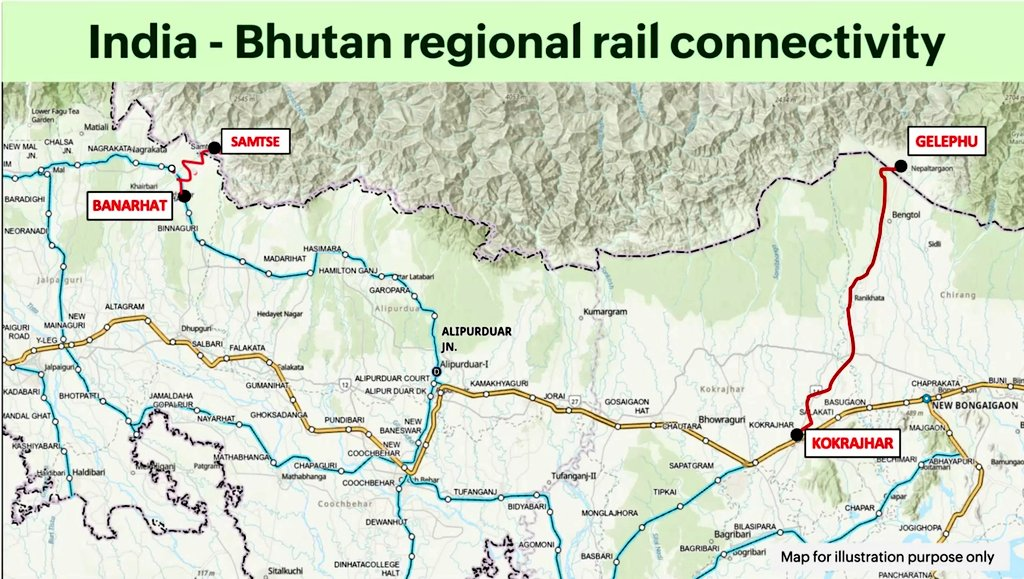
India to Extend Its Railway Grid to Bhutan
Introduction
GK & Current Affairs for CLAT | CLAT Current Affairs 2026
Powered by CLAT Gurukul – Best online coaching for CLAT
In a landmark move strengthening India’s neighborhood connectivity, the Government of India has announced two major railway projects linking India and Bhutan, marking a new chapter in regional cooperation and infrastructure diplomacy.
The projects — Kokrajhar (Assam)–Gelephu (Bhutan) and Banarhat (West Bengal)–Samtse (Bhutan) — aim to physically connect the Himalayan kingdom of Bhutan to India’s vast railway network for the first time in history. The initiative reflects India’s long-term strategy to enhance economic, strategic, and people-to-people ties with its Himalayan neighbor while countering China’s growing presence in South Asia.
Bhutan, notably, has no existing railway system, and this initiative will mark the first-ever rail entry into Bhutanese territory, thereby reshaping trade, connectivity, and diplomacy in the region.
For students preparing with the best online coaching for CLAT or tracking CLAT Current Affairs 2026, this topic is vital to understanding India’s neighborhood policy, international economic cooperation, and infrastructure-based diplomacy.
Why in News
- On September 30, 2025, the Indian government officially announced two cross-border railway projects connecting Bhutan with the bordering states of Assam and West Bengal.
- The projects include:
- 69 km Kokrajhar (Assam) – Gelephu (Bhutan) line
- 20 km Banarhat (West Bengal) – Samtse (Bhutan) line
- The projects will cost ₹3,456 crore and ₹577 crore, respectively.
- A Memorandum of Understanding (MoU) was signed between the Indian Railway Board Chairman Satish Kumar and Bhutan’s Foreign Secretary Aum Pema Choden.
- The projects are expected to:
- Strengthen India–Bhutan economic and diplomatic ties.
- Reduce Bhutan’s dependence on road connectivity.
- Counter China’s expanding influence in South Asia through infrastructure projects.
Background: Origins of the India–Bhutan Railway Projects
Historical Roots (2005 Onwards)
- The idea of establishing railway connectivity between India and Bhutan dates back to 2005, when:
- Naranbhai J. Rathwa, then Minister of State for Railways (India), and
- Lyonpo Khandu Wangchuk, then Bhutan’s Foreign Minister,
signed a Memorandum of Understanding (MoU) to explore potential cross-border rail links.
- The initial proposals included multiple routes:
- Hasimara (West Bengal)–Phuentsholing (18 km)
- Pasakha–Kokrajhar (Assam)–Gelephu (69 km)
- Pathsala (Assam)–Naglam (40 km)
- Rangia (Assam)–Samtse (West Bengal–Bhutan border)
- Banarhat (West Bengal)–Samtse (20 km)
- The Rail India Technical and Economic Services (RITES) conducted the feasibility studies and later submitted them to the Northeast Frontier Railway (NFR), which developed the final project proposals.
Revival of the Project
- Despite being conceptualized two decades ago, the projects gained real momentum after Prime Minister Narendra Modi’s visit to Bhutan in March 2024.
- During this visit, both sides finalized the implementation modalities and updated the technical MoUs.
- The Kokrajhar–Gelephu and Banarhat–Samtse lines were prioritized for their economic and geopolitical importance.
What Do the Projects Entail?
- Kokrajhar–Gelephu Line
- Length: 69 km (66.66 km in India + 2.39 km in Bhutan)
- Cost: ₹3,456 crore
- New Stations: Six – Balagaon, Garubhasa, Runikhata, Shantipur, Dadgiri, and Gelephu.
- Infrastructure Components:
- 10 major bridges
- 2 viaducts
- 29 minor bridges
- 65 culverts
- 39 underpasses
- 2 goods sheds
- Purpose: To directly connect Bhutan’s Sarpang district with India’s Kokrajhar and Chirang districts in Assam.
- Construction Period: 4 years.
- Banarhat–Samtse Line
- Length: 20 km (17.42 km in India + 2.13 km in Bhutan)
- Cost: ₹577 crore
- New Stations: Ambari and Samtse.
- Infrastructure Components:
- 1 major bridge
- 24 minor bridges
- 1 overpass
- 37 underpasses
- Purpose: To connect West Bengal’s Jalpaiguri district with Samtse district in Bhutan.
- Construction Period: 3 years.
- Implementation: To begin in the fiscal year 2025–26, pending land acquisition clearance.
Why Were Gelephu and Samtse Chosen?
- Strategic and Economic Relevance
- Gelephu and Samtse are key trade and industrial hubs of Bhutan.
- The Gelephu region lies close to India’s 700 km-long Assam–Bhutan border and has been declared a ‘Mindfulness City’ by Bhutan — envisioned as a sustainable hub integrating spirituality, innovation, and technology.
- Industrial and Trade Focus
- Samtse is being developed as an industrial township centered on manufacturing and exports.
- Bhutan’s major exports include ferro-silicon, dolomite, limestone, stone chips, and quartzite, much of which is sent to India.
- Ease of Connectivity
- Both Gelephu and Samtse have road infrastructure, allowing easy integration with rail terminals.
- These projects are expected to reduce Bhutan’s logistical dependence on road transport, which currently increases trade costs.
Strategic and Diplomatic Significance
- Strengthening India–Bhutan Ties
- Bhutan is India’s closest and most reliable neighbor in the Himalayas, sharing deep cultural, economic, and security ties.
- The rail projects symbolize India’s commitment to “Neighbourhood First” policy.
- They also reaffirm India’s support for Bhutan’s developmental priorities under its 13th Five-Year Plan.
- Countering China’s Influence
- China has intensified efforts to expand its influence in Bhutan through border negotiations and economic overtures.
- The Indian rail projects act as a soft power counterbalance, ensuring Bhutan’s continued reliance on India for connectivity and trade.
- Regional Economic Integration
- The project aligns with India’s vision of South Asian regional connectivity, connecting Bhutan to India’s Northeast and West Bengal, which in turn link to Bangladesh and Nepal.
- These links could pave the way for a Bhutan–India–Bangladesh multimodal trade corridor.
- Trade Facilitation and Employment
- India is Bhutan’s largest trading partner, accounting for over 80% of Bhutan’s total trade.
- The rail lines will:
- Reduce transport costs and times,
- Increase industrial competitiveness, and
- Generate local employment in both India and Bhutan during construction.
Why Is This Development Significant?
- Economic Transformation for Bhutan
- Bhutan currently relies entirely on road transport for all its trade.
- Railway connectivity will reduce dependency on trucks and lower carbon emissions.
- It will integrate Bhutan’s economy with India’s Eastern Economic Corridor, boosting export diversification.
- Enhanced Connectivity for Northeast India
- The new lines will strengthen Assam and West Bengal’s connectivity with Himalayan border regions.
- The projects are part of India’s Act East Policy, improving access from the Northeast to Southeast Asia via Bangladesh–Bhutan–India–Nepal (BBIN) corridor.
- Strategic Resilience
- Improved connectivity ensures faster troop and goods movement in case of border tensions, reinforcing India’s security preparedness along the Himalayan frontier.
- Strengthening India’s Global Image
- The initiative projects India as a responsible regional power investing in infrastructure diplomacy rather than coercive strategies.
Challenges and Implementation Concerns
- Land Acquisition Delays:
- Bhutanese terrain and limited land availability could slow project timelines.
- Environmental Clearances:
- The routes pass through fragile ecological zones in Assam and Bhutan’s foothills.
- Geopolitical Sensitivities:
- Bhutan’s cautious diplomacy vis-à-vis China may complicate project approvals.
- Coordination Between Agencies:
- Efficient synchronization between the Ministry of Railways (India) and Bhutan’s Ministry of Works and Human Settlement is critical.
The Larger Vision: India’s Rail Diplomacy
- India’s railway expansion into neighboring nations — Bangladesh, Nepal, and now Bhutan — is part of a broader effort to promote “connectivity-led integration”.
- The success of this project could inspire future extensions into Bhutan’s other towns like Phuentsholing and Thimphu.
- It also complements the ongoing Guwahati–Bangladesh rail connectivity and India–Nepal cross-border lines.
Conclusion
The extension of India’s railway grid to Bhutan represents more than an infrastructure milestone — it is a symbol of trust, partnership, and shared progress.
By bridging one of the last remaining connectivity gaps in South Asia, this project reinforces India’s Neighbourhood First and Act East policies while providing Bhutan with sustainable economic opportunities.
For CLAT 2026 aspirants studying with the best online coaching for CLAT, this development serves as a crucial case study on India’s foreign policy, regional cooperation, and infrastructure diplomacy — all of which are essential for understanding Current Affairs 2026 and legal reasoning related to international law and economic development.
Notes: Explanation of Key Terms
- MoU (Memorandum of Understanding):
A non-binding agreement between parties outlining mutual intentions and cooperation. - RITES (Rail India Technical and Economic Services):
A Government of India enterprise responsible for conducting feasibility studies and infrastructure planning. - Northeast Frontier Railway (NFR):
A railway zone under Indian Railways responsible for operations in the Northeastern states and bordering regions. - Viaduct:
A long bridge-like structure carrying a railway or road across a valley or low ground. - BBIN Initiative:
A sub-regional transport framework involving Bangladesh, Bhutan, India, and Nepal aimed at promoting cross-border movement of goods and people. - Neighbourhood First Policy:
India’s diplomatic strategy emphasizing economic and political cooperation with its immediate neighbors. - Act East Policy:
India’s foreign policy initiative to deepen engagement with Southeast Asian nations through trade and connectivity.
This Blog is Powered by CLAT Gurukul — India’s Leading Law Entrance Prep Platform
At CLAT Gurukul, we believe in empowering future legal minds with the right blend of knowledge, strategy, and mentorship. This blog is a reflection of our commitment to quality content that not only helps aspirants stay updated but also sharpens their conceptual clarity.
Why CLAT Gurukul?
- Personalized Mentorship by Top Legal Educators
- Comprehensive Study Materials & Legal Updates
- Daily Practice Sets, Mocks & Performance Tracking
- Result-Oriented Strategy for CLAT, AILET, and CUET
Whether you’re reading this article to deepen your understanding or to stay ahead in your exam prep — you’re already one step closer with CLAT Gurukul by your side.
Join thousands of successful aspirants who trusted CLAT Gurukul and cracked India’s top law entrance exams.
Visit https://www.youtube.com/@CLATGurukul/shorts to learn more or speak to our experts now!
Note from CLAT Gurukul
At CLAT Gurukul, we are committed to providing free CLAT study material, including CLAT current affairs, legal reasoning practice sets, general knowledge updates, logical reasoning questions, English comprehension exercises, and more — all curated by top mentors.
Our blog section is regularly updated with high-quality CLAT content tailored to match the evolving pattern of the CLAT UG exam. Whether you’re looking for CLAT 2026 current affairs, CLAT legal reasoning passages, or mock practice sets, we have you covered.
We believe in open-access learning and will continue to publish free CLAT preparation resources to help serious aspirants succeed.
Explore more free content under categories like:
Best online coaching for CLAT, CLAT current affairs, CLAT GK updates, CLAT legal updates, CLAT logical reasoning, and CLAT English preparation.
For structured learning, daily mocks, and expert mentorship, visit https://www.youtube.com/@CLATGurukul/shorts — the Best CLAT Coaching in Patna and India’s most trusted platform for CLAT online coaching.
